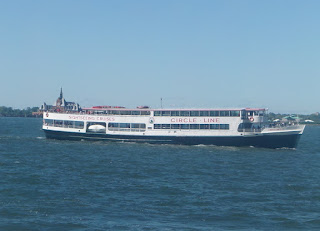While a passenger on the Number 1 train yesterday morning, a
man got on carrying a small American flag. I logically assumed the flag was a
prop for an impending subway car performance. However, life is full of
surprises, especially on a New York City subway. The fellow walked right past me
and entered the adjoining car without so much as a peep. This transpired on my
downtown ride. On the return trip home, the same man appeared, but this time
he didn’t disappoint and promptly launched into his act. In good voice, he sang
“God Bless America” while waving his little flag.
After the last verse, “God bless America, my home, sweet
home,” the subway songster announced that he was not “homeless, hungry,
harmful, or pregnant.” He then got to the business at-hand. “If you like
what you hear,” he said, “I’d appreciate a donation.” To prove that his
act was multi-dimensional—and included ample doses of comedy—he added, “If you
do not hear what you like, I will take a bribe to shut up!”
This rather unique subway show was far from over as the man
performed for the Spanish-speaking riders. He belted out the familiar folk song
“La Cucaracha” and then supplied us with some blue biographical information. He
referenced his previous night’s roll in the hay with his randy third wife. By
the blank looks on their faces, I don’t think too many of my fellow passengers
appreciated the width and breadth of this guy's talents. After mentioning
the enchanted evening with his wife, he pretended that he was reliving it—on
the morning after—and became breathless and temporarily lost in space. When he
returned to earth—and the subway car—from this heavenly recollection, he
thanked all of us for being “a captive audience fifty feet underground.”
I typically give to panhandlers on the subway—homeless or
otherwise—but didn’t make the effort to bequeath anything to the man of song. I
don’t exactly know why. For one, it’s not easy to get money out of your pocket
when you’re crammed next to somebody on a subway seat. Perhaps I was thrown off
my usual routine by his unusual routine, which was hardly run-of-the-mill
subway entertainment.
Interestingly, just as the songster-comedian exited the
subway car, another chap entered. He, however, said he was homeless, had
experienced a run of bad luck, and was in dire straits. This time, I made the
effort to unearth a dollar bill from my pocket. But I should have also given
the “God Bless America” guy a “donation.” After all, his parting salvo noted
the many payments that he accepted, including “credit cards” and “gift cards.”
If there is a next time, he’ll get a well-earned couple of bucks from me.
(Photographs from the personal collection of Nicholas Nigro)















